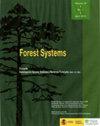林分特征对云杉和落叶林土壤有机碳含量的影响
IF 0.7
4区 农林科学
Q3 FORESTRY
引用次数: 1
摘要
研究目的:确定与森林管理实践密切相关的林分特征对云杉和落叶林有机质(O)和表层矿物(A)土层中土壤有机碳(SOC)含量的影响,并展示生产林分生命周期中的SOC动态。研究区域:捷克共和国各地的云杉和落叶林。材料和方法:在中低海拔云杉和落叶林(401个样地)中,评价了林分年龄、放养密度和冠层对O和A层SOC含量的影响,以及变量类别之间的差异和SOC的趋势。主要结果:SOC含量在林分寿命期内发生变化。在云杉林中,SOC随林分年龄的增加呈下降趋势。在落叶林中,SOC含量在A水平上总体较高,随着林分年龄的增长略有波动,但在林分寿命期间更为平衡。根据研究结果,在濒危云杉林的管理和碳固存方面,云杉林应在81-120岁年龄组进行砍伐,而落叶林应在较老的林分(141岁及以上)进行砍伐。林分蓄积密度和郁闭度对有机碳含量无显著影响。研究重点:就碳固存而言,落叶林有可能取代海拔较低的垂死云杉林。本文章由计算机程序翻译,如有差异,请以英文原文为准。
The effect of stand characteristics on soil organic carbon content in spruce and deciduous stands
Aim of study: To determine the effects of stand characteristics, which closely relate to forest management practices, on the soil organic carbon (SOC) content in the organic (O) and surface mineral (A) soil horizons in spruce and deciduous stands, and to show SOC dynamics during the life of production stands.
Area of study: Spruce and deciduous stands located throughout the Czech Republic.
Material and methods: The effects of age, density of stocking and canopy of stand on SOC content in the O and A horizons, and the difference between categories of variables and the trends of SOC were evaluated in spruce and deciduous stands (401 plots) at lower and middle elevations.
Main results: SOC content changed during the life of stands. In spruce stands, a decreasing trend of SOC with stand age was found in the A horizon. In deciduous stands, SOC content was higher overall in the A horizon, fluctuating slightly with stand age, but more balanced during the life of stands. Based on the results, in terms of management of dying spruce stands and carbon sequestration, felling should be carried out in the age group of 81-120 years in spruce stands, whereas in deciduous stands felling should take place in older stands (141 years and more). Density of stocking and canopy of stand had no substantial effect of SOC content.
Research highlights: Deciduous stands have the potential to replace dying spruce stands at lower elevation in terms of carbon sequestration.
求助全文
通过发布文献求助,成功后即可免费获取论文全文。
去求助
来源期刊

Forest Systems
FORESTRY-
CiteScore
1.40
自引率
14.30%
发文量
30
审稿时长
6-12 weeks
期刊介绍:
Forest Systems is an international peer-reviewed journal. The main aim of Forest Systems is to integrate multidisciplinary research with forest management in complex systems with different social and ecological background
 求助内容:
求助内容: 应助结果提醒方式:
应助结果提醒方式:


